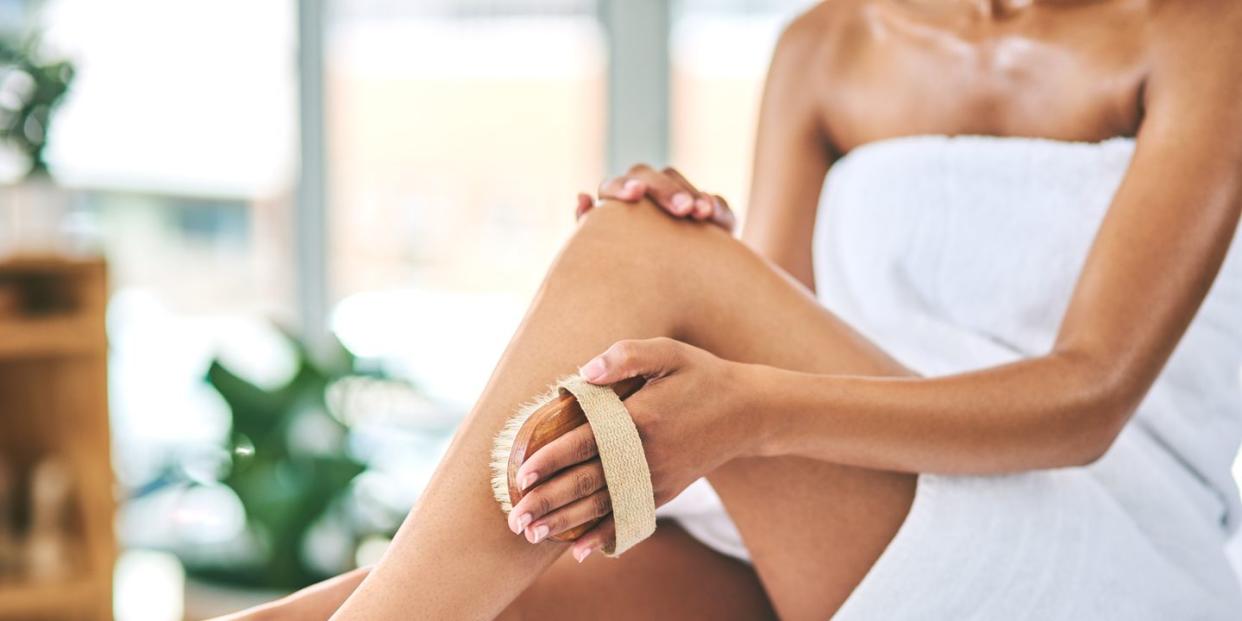All of Your Questions About Dry Brushing, Answered

"Hearst Magazines and Yahoo may earn commission or revenue on some items through these links."
Of all the ways to exfoliate your skin (read: body scrubs, shower loofahs, and body washes rich in AHAs and BHAs), dry brushing is the most intriguing because it doesn't involve water. Instead, the practice involves rubbing your dry skin with stiff-bristled brush, and it’s gotten a lot of buzz from wellness gurus for the reported slew of benefits. It sort of feels like a massage, only takes a few minutes, and can help with everything from lymphatic drainage to improved circulation and cellular exfoliation, purportedly helping to make your skin glow. Sound too good to be true? Ahead, dermatologists answer all of your questions about dry brushing, including how to do it correctly and how to reap the benefits.
The benefits of dry brushing
“Dry brushing, or when you use a large bristle brush to massage the skin while it’s dry, helps to exfoliate and increases blood flow,” says Sapna Palep, MD, of Spring Street Dermatology in New York City. While benefits aren’t clinically established, the dermatologists we spoke with regard it as a worthwhile practice.
“Proper dry brushing is a great, natural, mechanical exfoliation process that yields excellent results,” says Ava Shamban, MD, a cosmetic dermatologist. “The cellular stimulation and turnover provides oxygenation of the skin cells, which is both visually beneficial and highly effective.” The gentle friction from the dry bristles is invigorating, and the exfoliating restores fresh new cells, brightening the skin.
It’s also believed that dry brushing can improve your skin tone by increasing blood circulation and flow. “Some people find that it helps de-puff the skin, as it can help with lymphatic draining,” says Howard Sobel, MD, a board-certified dermatologist,
“Manual exfoliation helps to reduce inflammation,” adds Dendy Engelman, MD, a board-certified dermatologist. “This stimulates the lymphatic system because blood increases in that area and eliminates waste. The removal of waste and toxins can have a tightening, or de-puffing, effect.” However, it doesn’t tighten permanently.
How to do dry brushing
It’s not as simple as brushing your hair; there’s a preferred process for maximizing benefits. “Start at your feet and brush upward toward the heart using firm, small strokes, and work in a circular motion,” advises Peterson Pierre, MD, a board-certified dermatologist. “Similarly, when you move on to your arms, start at your hands, and work upward. For your belly, work in a clockwise direction.”
Once you’re done, Palep recommends taking a shower to wash off all the dead skin cells. “Follow with a body moisturizer or oil on dry, washed skin,” Palep says. Bonus: Because dry brushing removes dry, flaky skin, your products will be able to penetrate better, says Sobel.
If you have sensitive skin, experts advise proceeding with caution. “Dry brushing can irritate sensitive skin, so it’s probably best to avoid it. Try a chemical exfoliator instead,” says Palep, adding, “for any skin type, it’s important not to brush the skin too hard. Dry brushing should not hurt, so ease up on the amount of pressure you use with the brush. Gentle massage is always best.”
Also, avoid dry brushing during winter months, says Harold Lancer, MD, a board-certified dermatologist and founder of Lancer skincare. “I suggest, instead taking a steam-filled shower with high humidity, and exfoliate by hand or with a washcloth,” he says.
“Just about anyone can try dry brushing—but if you have a history of eczema or psoriasis, you should probably avoid it altogether, because it can worsen your condition,” adds Pierre.
Is dry brushing good for cellulite?
If only getting rid of cellulite were so simple! “Cellulite is enlarged packets of body fat deep beneath the skin pushed against the vertical connective tissue that surrounds fat cells,” says Engelman. “When the fat cells expand, it limits the space under the skin and puts pressure on the connective tissue. The pressure forces the fat against the top layers and creates the 'cottage cheese' look.” She explains that because—as we noted—dry brushing increases circulation, it can aid in lymphatic drainage and help improve the appearance of cellulite—appearance being the key word.
“An increased blood flow strengthens connective tissue, eliminates toxins, and delivers nutrients to the area. Once you stop, cellulite will come back. Any effect is short-lived and probably due to the removal of excess fluid,” says Engelman.
How to choose a dry brush
Sobel says, “Dry brushing is particularly beneficial for skin types who can’t tolerate chemical exfoliation. When choosing a dry brush for your skin, make sure you choose one with natural, soft, gentle bristles so it doesn’t irritate you. Do not use dry brushes made for your body on your face. Also, avoid overdoing it. If your skin is red and flushed from dry brushing, you’re exerting too much pressure or dry brushing way too often.”
You Might Also Like

